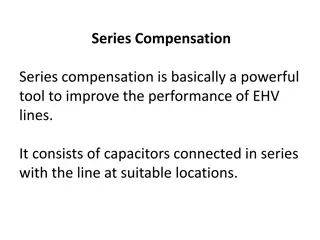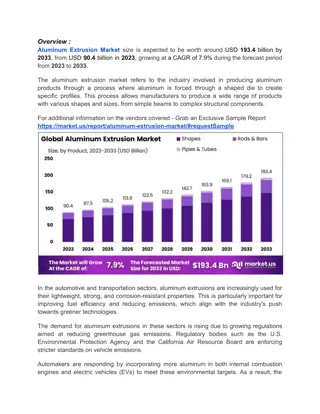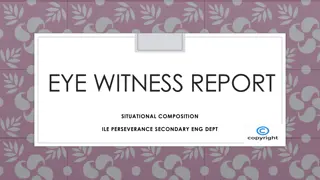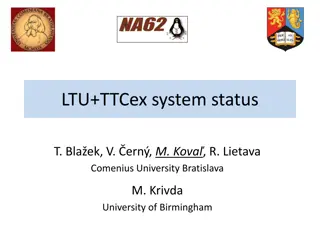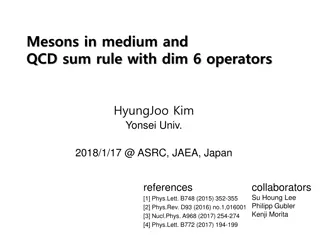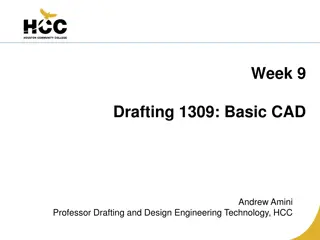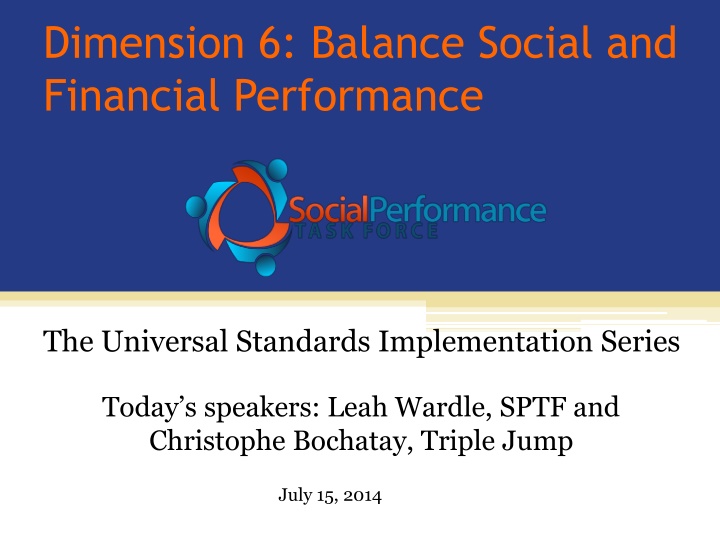
Achieving Balance: Universal Standards for Social and Financial Performance
Explore Dimension 6 of the Universal Standards focusing on balancing social and financial performance in institutions, covering growth, returns, pricing, and executive compensation. Learn essential practices for sustainable growth, aligning financial structures, ethical pricing, and maintaining long-term sustainability. Join experts in discussions to enhance your institution's impact today.
Download Presentation

Please find below an Image/Link to download the presentation.
The content on the website is provided AS IS for your information and personal use only. It may not be sold, licensed, or shared on other websites without obtaining consent from the author. If you encounter any issues during the download, it is possible that the publisher has removed the file from their server.
You are allowed to download the files provided on this website for personal or commercial use, subject to the condition that they are used lawfully. All files are the property of their respective owners.
The content on the website is provided AS IS for your information and personal use only. It may not be sold, licensed, or shared on other websites without obtaining consent from the author.
E N D
Presentation Transcript
Dimension 6: Balance Social and Financial Performance The Universal Standards Implementation Series Today s speakers: Leah Wardle, SPTF and Christophe Bochatay, Triple Jump July 15, 2014
Agenda Review of Dimension 6 of the Universal Standards Presentation by Christophe Bochatay, Triple Jump Discussion with Participants
Dimension 6 of the Universal Standards Title: Balance Social and Financial Performance Rationale: An institution s financial decisions and results should reflect their social goals. Four standards: 6a- Growth 6b- Returns & financing structure 6c- Pricing 6d- Executive compensation
6a- The institution sets and monitors growth rates that promote both financial sustainability and client well-being. Essential Practices Set a policy on sustainable target growth rates, for all branches/regions and all product types, considering the institution's growth capacity and the markets being targeted. Analyze growth rates and market saturation to assess whether growth policies ensure both financial sustainability and client well-being. Monitor whether internal capacity is keeping pace with institutional growth in number of clients and amount of loans and deposits, and enhance that capacity as needed.
6b- Equity investors, lenders, board and management are aligned on the institution s double bottom line and implement an appropriate financial structure in its mix of sources, terms, and desired returns. Essential Practices Set clear policies on desired level of returns and on how those returns will be used. Engage with funders whose expectations for financial returns, timeframe and exit strategies are aligned with your social goals and stage of development. When deciding on funding sources, understand what cost would be passed on to the client. Protect client savings and cash collateral. Maintain a transparent financial structure.
6c- Pursuit of profits does not undermine the long- term sustainability of the institution or client well- being. Essential Practices Set market-based, non-discriminatory pricing. Ensure efficiency ratios are aligned with peers. Do not charge excessive fees. Monitor whether pricing levels are consistent with your policies on returns. Establish a field-officer-to-client ratio that promotes high service quality for clients.
6d- The institution offers compensation to senior managers that is appropriate to a double bottom line institution. Essential Practices Ensure that compensation of the CEO/Managing Director and other senior employees is in line with your social goals. If senior management compensation is in part incentive-based, include the social performance evaluation. Upon request, transparently disclose compensation to regulators, auditors, raters, donors, lenders, and investors. Calculate the difference between the average compensation of top level executives and field employees, and analyze whether this spread is consistent with the your mission.
Presentation by Christophe Bochatay, Triple Jump Senior Investment Officer, Africa & Middle East
Introduction to the Interest Traffic Light ->Universal Standard 6C Profitability can come at the expense of clients well being. A double bottom line institution needs to balance profitability and social mission. Imperfect competition and vulnerability of clients mean that markets are not self- regulating. Investors have a strong role to play to contribute to responsible pricing and profits. The appropriate level of interest rate depends from a complex mix of factors including social mission, costs, competition, regulation, etc. Structured and consistent approach The Interest Traffic Light Aselection tool to evaluate whether Interest Rates charged by MFIs and their Profitability are justified or not. Objectivity Transparency First introduced by TJ in 2010 Accountability
Part I screens 3 criteria to establish if deeper analysis is needed Criteria Question asked / Input factors Threshold What is the average APR of the MFI? APR of each of the MFI loan products Number of outstanding loans Weighted average APR > 50% A APR (1) How does the APR compare to APR of peers? Average APR as calculated under (1) above APR of 3 most similar MFIs in the country APR relative to peers Average APR > 1.2x peer average B How profitable was the MFI over last 3 years? Return on Assets (RoA) Return on Equity (RoE) RoA > 6% RoE > 25% C Profitability If one of the three Criteria is above the Threshold, then a deeper analysis is required: Part II needs to be filled (1) Annual percentage rate (non-compounded)
Part II analysis looks in more details at APR and profitability Scoring points Dimension Question asked / Input factors LEAST MEDIUM MOST 1 APR What is the average APR of the MFI? > 80% 50-80% < 50% How does the APR relate to average loan size? Use approx. universal APR vs. loan size curve Divide APR of MFI / APR indicated by curve 2 > 1.1x 0.9 1.1x < 0.9x APR vs loan sizes APR relative to peers 3 How does the APR compare to APR of peers? > 1.2x 0.8 1.2x > 0.8x 4 > 6% 2-6% < 2% Profitability What is the level of RoA?
compares interest rates to business returns of end clients Scoring points Dimension Question asked / Input factors LEAST MEDIUM MOST Added value to clients Spread between APR charged by MFI and end borrower s net business margin 5 <2% 2-10% >10%
and considers a number of mitigating factors Scoring points Dimension Question asked / Input factors LEAST MEDIUM MOST Are there specific factors in the environment that contribute to higher than usual costs for the MFI? 6 no 1 factor 2+ factors Cost in the operating environment High salary levels Very rural MFI with large distances High administrative costs High borrowing costs Inflation 10% or above Has 7 lowered rates or has plans to do so Efforts to lower rates Did the MFI lower APRs and/or has credible plans to do so in the near future? No both Does the MFI distribute its profit or reinvest it in the institution? > 33% dividend < 33% dividend No 8 Use of profits dividend Are there factors in which make it necessary to build up an equity cushion? Below standard solvency Specific regulatory requirements which the MFI struggles to fulfil Currency fluctuation 15% or above Significant political instability Recurring natural disasters 9 no 1 factor 2 factors Equity cushion
Outcome of traffic light influences TJ investment decision GREEN: No specific actions required, general monitoring of situation YELLOW: The following set of actions should be implemented, taking into consideration the sustainability of the MFI: Approval of the loan subject to a commitment in writing from the MFI to lower effective rates within a 12-18 month period (e.g. the MFI agrees to pass on reductions in the total cost ratio to clients) Loan Tenor reduced to a maximum of 24 months TJ Investment Officer to review effective interest rate annually and result to be included in annual progress report to the fund under management. RED: Not eligible for investment
Download the Interest Traffic Light at: www.interesttrafficlight.org
Executive Compensation Questionnaire ->Universal Standard 6D Developed to standardize our assessment of CEO s remuneration package and designed to provide our investment committees all the elements to make a decision TJ requires the MFI to be transparent on the compensation of its CEO We define here the CEO compensation package as the gross sum of salary, bonuses and pension benefits received by the CEO during the last fiscal year All MFIs reporting a total CEO compensation package above USD 150.000 must be further assessed through a set of 6 questions
Executive Compensation Questionnaire 1. Is the structure of the compensation package appropriate? Incentive systems and inclusion of longer term targets Stock options Is the board setting compensation and is the board sufficiently independent Ratio of CEO compensation to the one of junior loan officers 2. Is the compensation package in-line with executive compensation packages of peers? 3. Are there elements that make the MFI a particularly complex institution to manage? Legal form Size of the institution
Executive Compensation Questionnaire 4. Does the performance of the CEO stand out? Compare performance against peers in terms of growth, sustainability, outreach and SPM 5. Are there any elements in the operating environment that justify higher compensation? Living expenses, hardship, availability of skilled executives 6. Are profits and interest rates at acceptable levels? Is the Interest Traffic Light green?









